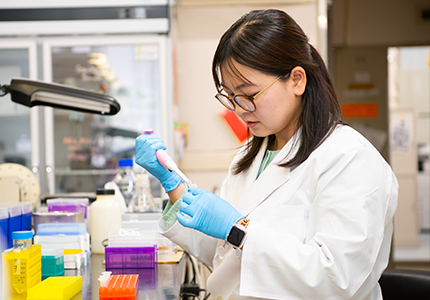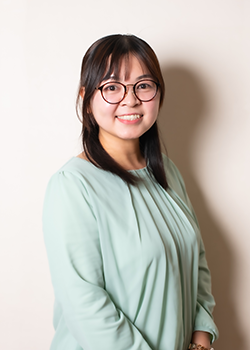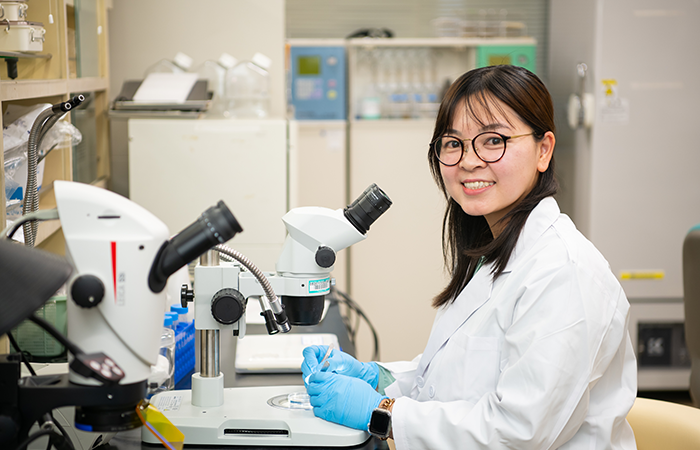Developing Genetically Engineered Mice to Help Elucidate the Pathogenesis of Intractable Diseases
BRC is supported by a diverse staff who are involved in a variety of tasks. We have interviewed staff members from each of the 12 laboratories that make up BRC, asking them about their activities and their day-to-day efforts in their research rooms.
This time, we are speaking with Tra Thi Huong Dinh, who is a development researcher in the Next Generation Human Disease Model Team.
After working as a doctor in Vietnam, she came to Japan to pursue her own research. We interviewed her about what she values in research and daily life to keep a positive attitude as a researcher and as the mother of three children.
Aiming to elucidate disease onset mechanisms using model mice
Intractable diseases, age-related diseases, and lifestyle diseases can impose an extremely heavy burden on patients, their families, and society. The pathogenic mechanisms that underly these diseases are still largely unknown. In the Next Generation Human Disease Model Team, we are using genome editing technology to develop and analyze models that reproduce the pathological conditions of human diseases and study these models intending to elucidating the pathogenic mechanisms of these diseases.
The specific flow of the research is as follows. First, we create genetically modified mice using genome editing technology based on the patient’s genome and variant information (*1). Then, we perform genotypic and phenotypic analyses (*2) to confirm the target disease. For phenotyping analysis, we utilize comprehensive characteristic inspection conducted by the Japan Mouse Clinic (*3) and we also work closely with clinical researchers to conduct more detailed pathological condition assessments and pharmacological evaluations of therapeutic candidates. By doing so, we contribute to the promotion of preclinical studies that form the basis for diagnosis, and treatment. The human disease models generated through this process are then utilized in clinical trials, therapy and drug discovery.
Our research, in other words, bridges the gap between experimental science and clinical research, and our models are useful applications to support human health.

Becoming a researcher after working as a physician in Vietnam
After graduating from Ho Chi Minh Medicine and Pharmacy University (UMP) in Vietnam, I worked as a doctor and lecturer at UMP for two years. I studied medicine and pharmacy at university in Vietnam and majored in traditional medicine, and I was actually more interested in fields related to people.
During this time, I became interested in molecular and developmental biology, and my desire to learn about this field grew over time.
I came to Japan under the Doctoral Education Leading Program (Ph. D. Program in Human Biology) at the University of Tsukuba, where I worked on research using knockout (*4) mice to gain a deeper understanding of the role of target genes. After graduation, I worked as a researcher at the Laboratory Animal Resource Center of the University of Tsukuba, and I joined BRC in 2022.
My family is one of the most important things that supports me as a researcher. My three daughters, who were born in Japan, are now in elementary school and preschool,and sometimes I have to take time off work due to sudden illnesses, which can create difficulties at work. However, spending time with my family, playing with my children, and talking about what happened during the day helps to keep my spirits up. On vacation, we spend time on sightseeing and camping trips to refresh ourselves. So far, we have been to various places like Toyama, Gunma, Shizuoka, and Yamanashi. Last summer, we could return to Vietnam after the long-time restriction due to the COVID-19 pandemic.
Challenging and pursuing research with the ultimate goal of improving human health
"Positive thinking," "Continuing to learn and take on challenges," "Discovering new external and internal aspects, new phenomena and your own abilities," and "Maintaining a good work-life balance"—these are the things I want to keep in mind at work and home. In addition, I try to balance work and family life by "Allocating my time efficiently," "Getting great support from my family," "Trying to do things as promptly as possible," and "Doing everything in a fun way."
And the keywords for spending time comfortably and enriching my life, both public and private, are "Look on the bright side," "Relationships matter," and "Stress-free." Some of my favorite quotations give me hope and courage when I feel lost or have doubts about my way of life.
"Nothing in life is to be feared, it is only to be understood" — Marie Curie
"Happiness is not having what you want, but wanting what you have" — Rabbi Hyman Schachtel
These words remind me that human beings tend to be fearful of what they do not know, but by getting closer to the subject and understanding it, we can cast aside our fears. If we remain curious and interested in everything without fear, scientific research will provide us with the answers. With this in mind, I would like to continue my journey of scientific discovery, which I consider to be also a process of self-discovery.
My current research focuses on neurodegenerative diseases, particularly amyotrophic lateral sclerosis (ALS).
During my time in Vietnam, I initially believed that interacting directly with patients suffering from diseases would be more interesting than working in a laboratory conducting experiments. However, I eventually became aware that my research could lead to curing patients, which motivated me to pursue this avenue.
On the other hand, I am also expanding my ability to willingly engage and immerse myself in detailed research work.

At present, I am conducting experiments while considering that there are patients beyond this experiment, and that I am always connected to someone. With the help of my family and the other people around me, I hope to create a pipeline to investigate the phenotype and pathological conditions of the ALS model in the near future.
- *1 Genome and variant information: Information on differences in DNA sequences between individuals
- *2 Genotypic and phenotypic analyses: Approaches used to study the relationship between an organism’s genes (genotype) and its observable traits (phenotype)
- *3 Japan Mouse Clinic: Comprehensive phenotyping support service provided by the Mouse Phenotyping Analysis Division at RIKEN BRC to the domestic research community
- *4 Gene knockout: The targeted removal, disabling or inactivation of specific gene functions within an organism’s genome by genetic manipulation
Profile
- Tra Thi Huong Dinh
- Research & Development Scientist, Next Generation Human Disease Model Team
- Joined RIKEN BRC in 2022. Currently, she is involved in the production of models that reproduce the pathological conditions of intractable diseases and lifestyle diseases in order to elucidate the mechanisms of pathogenesis of these diseases.
Release date : May 21, 2024
